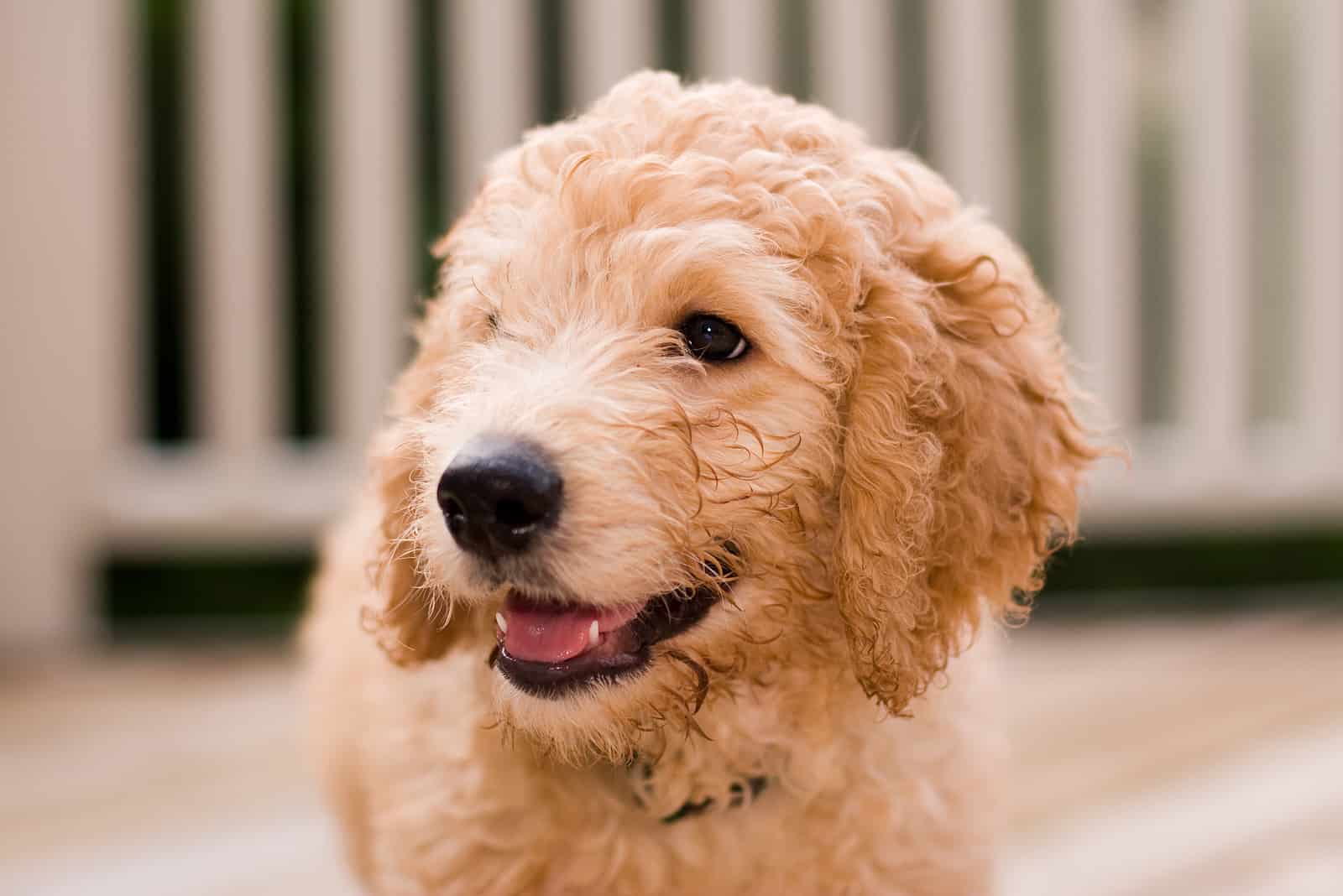Black, apricot, and cream Labradoodle colors might be popular among owners of this mixed breed, but there are many more shades and patterns that equally enhance the beauty of the crossbreeds and their coat.
Labradors and Poodles are cute, but their cross puppies are even more appealing, no matter which shade they’re colored in.
These hybrid doggies contain the best traits of both purebred canines, which is why they were crossed in the first place.
If you want to learn more about all the Labradoodle colors, all you need to do is keep scrolling and read the complete guide of the beautiful shades of this crossbreed!
Labradoodle Colors
Mixed breeds usually inherit the traits of both parent breeds, including the different colors of their coat, temperament, and physical features.
Labradoodles’ hairstyle is similar to Poodles, which isn’t surprising considering that the Poodle parent also inherits the curls from the Labradoodle’s coat.
The type of hair might not be a heritage of Labrador Retrievers, but their coat shades might be… at least Lab colors like chocolate, cream, black, and others.
All of these hues will be described in the paragraphs below, including the rarest Labradoodle shades that you might not have come across before.
1. Apricot
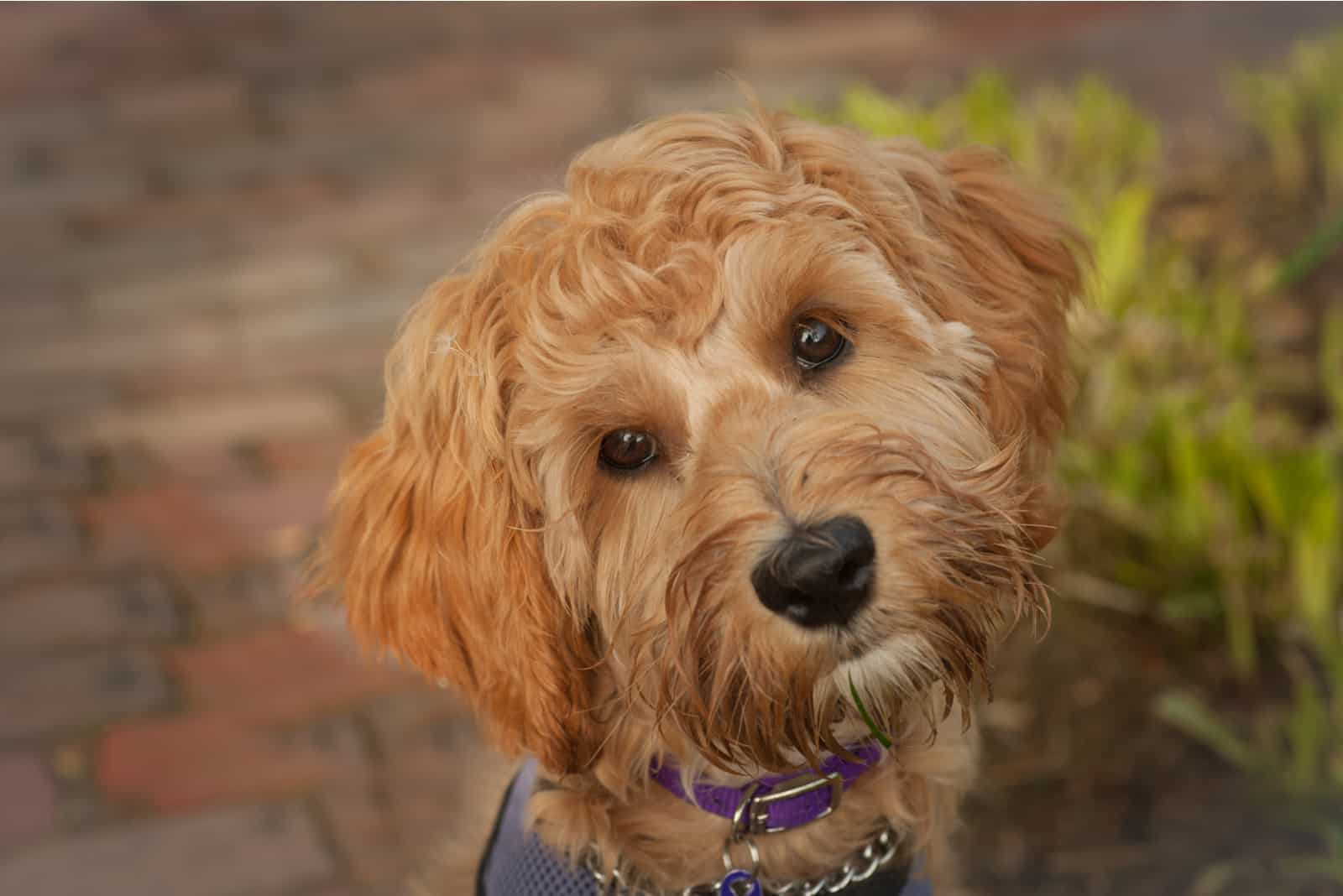
This type of Labradoodle coat color is also known as the golden Labradoodle because it resembles the trademark color of Golden Retrievers.
However, the apricot hue is acknowledged as one of the official colors of Poodles – one of the parent breeds of Labradoodles, and the color gene carrier.
Apricot Labradoodles are one of the most popular types of this mixed breed mainly because they remind us of fluffy teddy bears.
Even though the majority of their coat is colored in the apricot shade, the pigment around the nose, eyes, and paws is usually colored in black or in dark brown.
Don’t be surprised if your crossbreed becomes lighter as it gets older… to the point that it might even be confused for a Cream Doodle.
2. Red
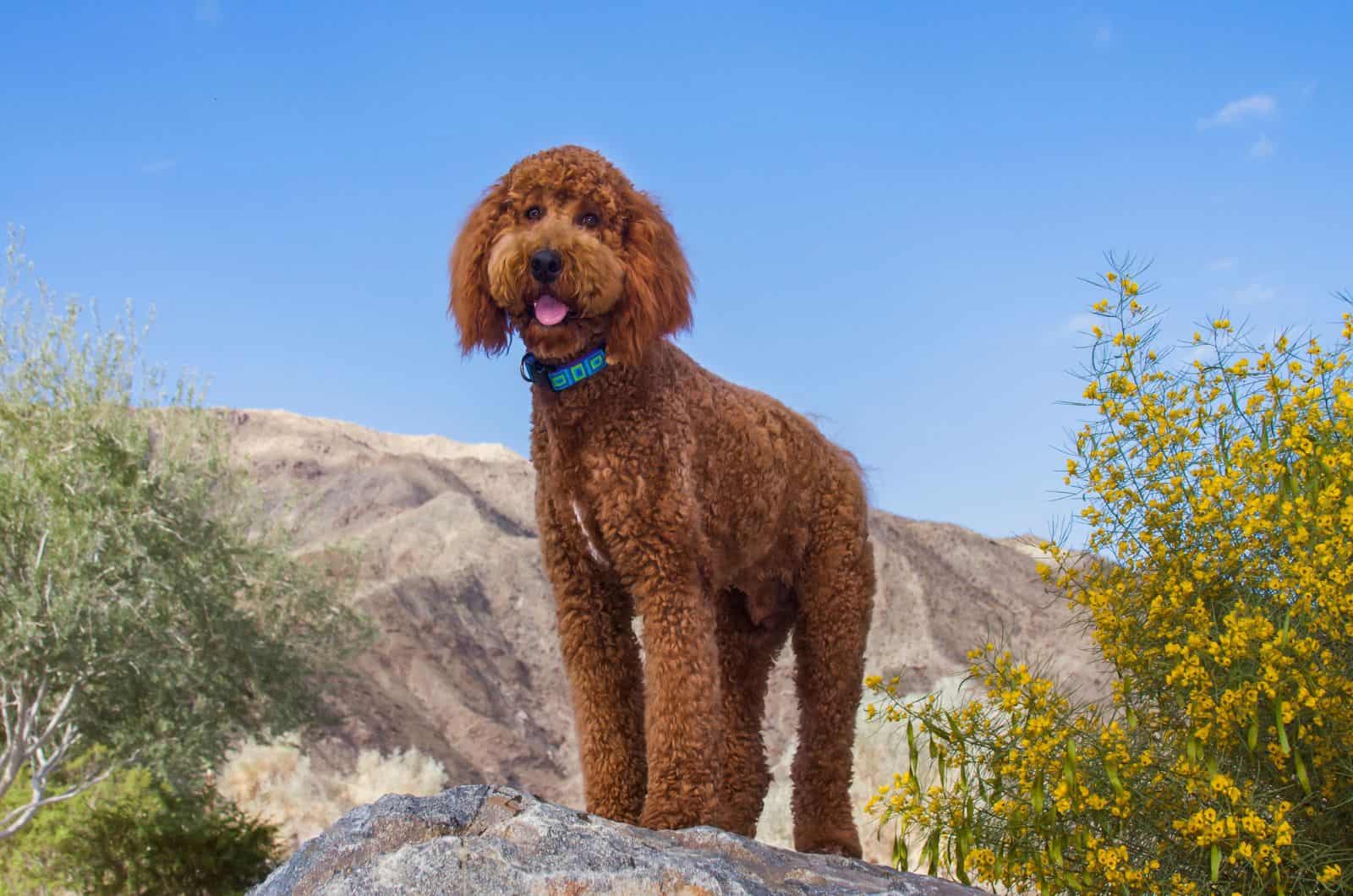
Experts in Doodles will immediately know that the red Labradoodles inherited this shade from red Poodles – their parent breed.
However, the red color gene is recessive, which is why it’s more challenging to produce Labradoodles of this color.
This shade is quite similar to the apricot color, but Red Labradoodles have a significantly deeper hue.
This type of shade could also be described as a mahogany hue because they share almost the same richness in color.
The American Kennel Club does not recognize the color red as an official Poodle or Labrador Retriever coat shade.
On the other hand, Labradoodle breeders frequently refer to this canine as “red” due to the fact that this coat shade is a result of crossing a regular tanned or cream Lab with a deeper-colored Poodle (red, if possible).
RELATED: Top 10 Most Responsible Labradoodle Breeders In Ontario
3. Parti
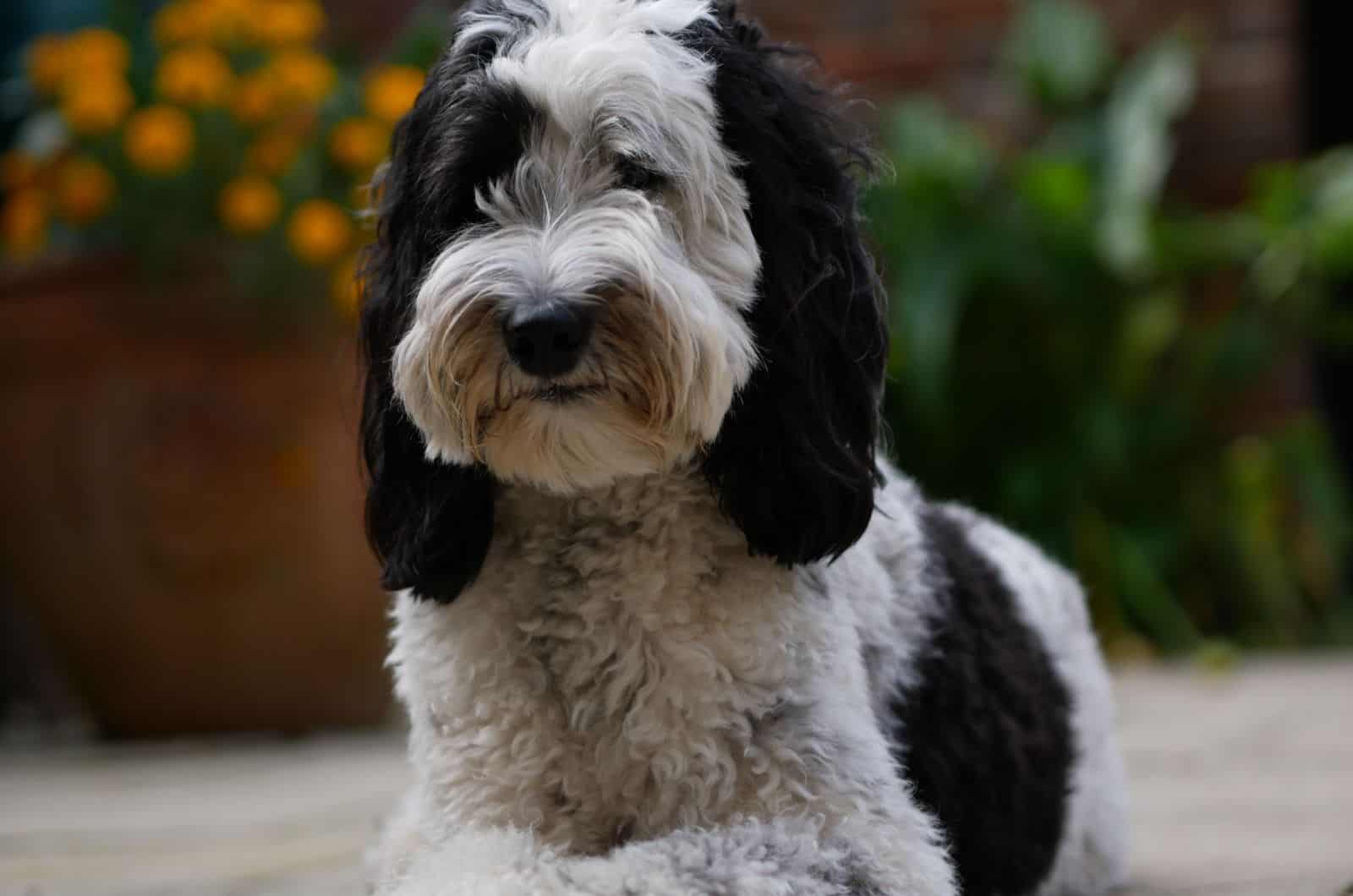
Have you ever heard of a Parti Poodle? I’d wish to say that this is a type of Poodle that loves to party, but this time, it’s about the coat shade that consists of multiple colors.
One of the most common misconceptions about Parti Labradoodles is that they’re a mix of a Lab and the Parti Poodle. However, the Lab doesn’t carry this color gene.
In order to get a Parti pattern, both parent breeds have to be carriers, which is why this pattern is commonly present only in F1 and F1b Labradoodles and those of higher generations.
The Parti Poodle Lab cross has two distinct coat shades – one being white, which serves as the base color, while the other shade might be in any Poodle hue, except for brown or golden/apricot.
When looking at a Parti Labradoodle, you can also see tints of silver or blue every once in a while.
These pups also have a black nose in most cases, just like the Labradoodle types mentioned above.
4. Cream
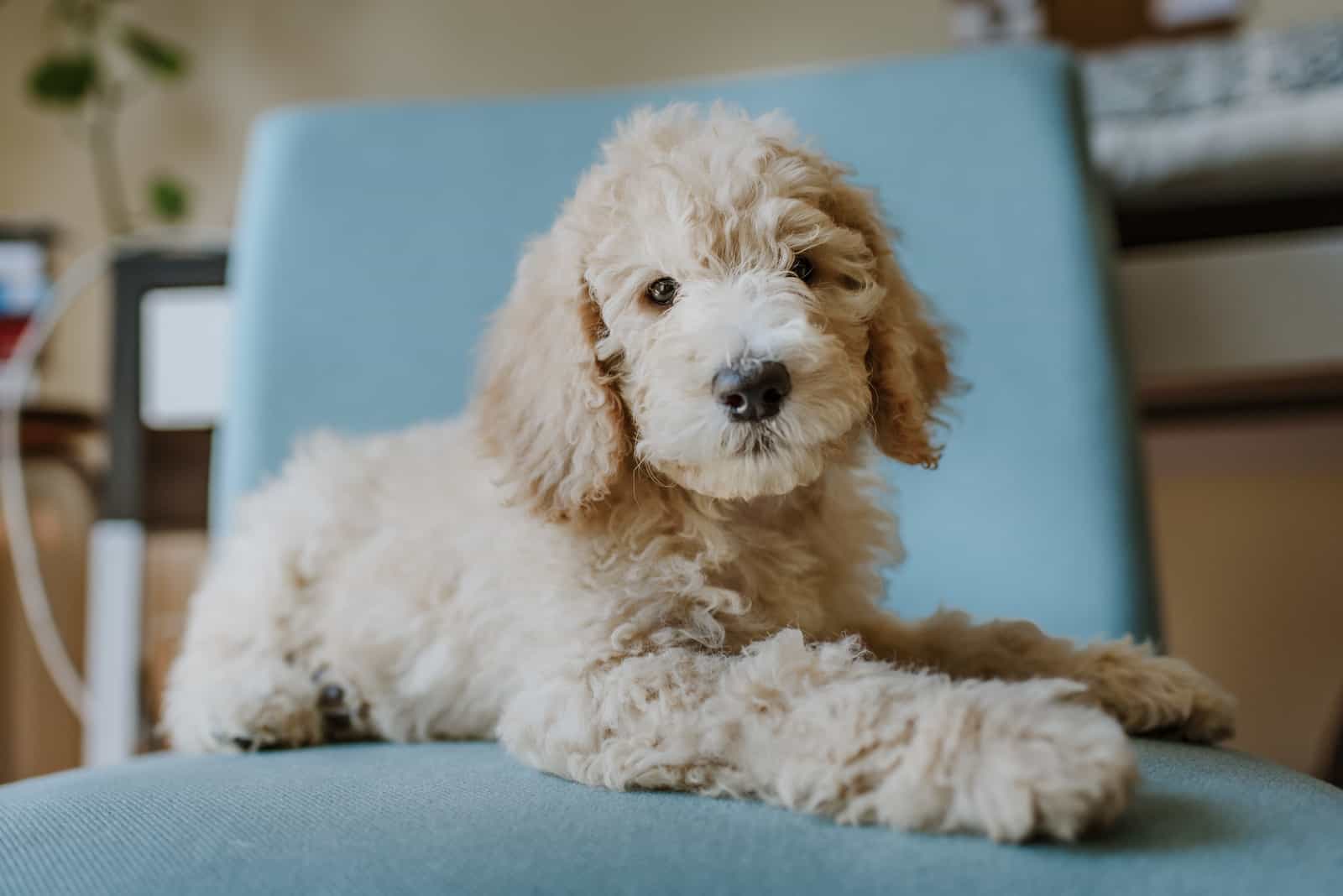
Cream Labradoodles (also known as caramel cream) are one of the most prevalent types of Labradoodles, which are often related to white or golden pups, even though their coat is darker than white, but paler than the apricot ones.
The color of their fur is supposed to be uniform throughout their entire coat, although some pups might have a little deeper tint concentrated on the areas around the eyes, nose, and mouth.
This type of color is often used as a base shade for other Labradoodle colors, such as merle, parti (in some cases, although white appears much more often), and Phantom Labradoodles.
An interesting fact about this type of Doodle is that even though it’s one of the most common colors among Lab and Poodle mixes, it’s still quite unique as their characteristics vary greatly depending on the colors and traits of their parent breeds.
Therefore, some cream pups might end up with a black or a brown nose, eyes of varying colors, and even paws in brighter or deeper shades.
5. Black
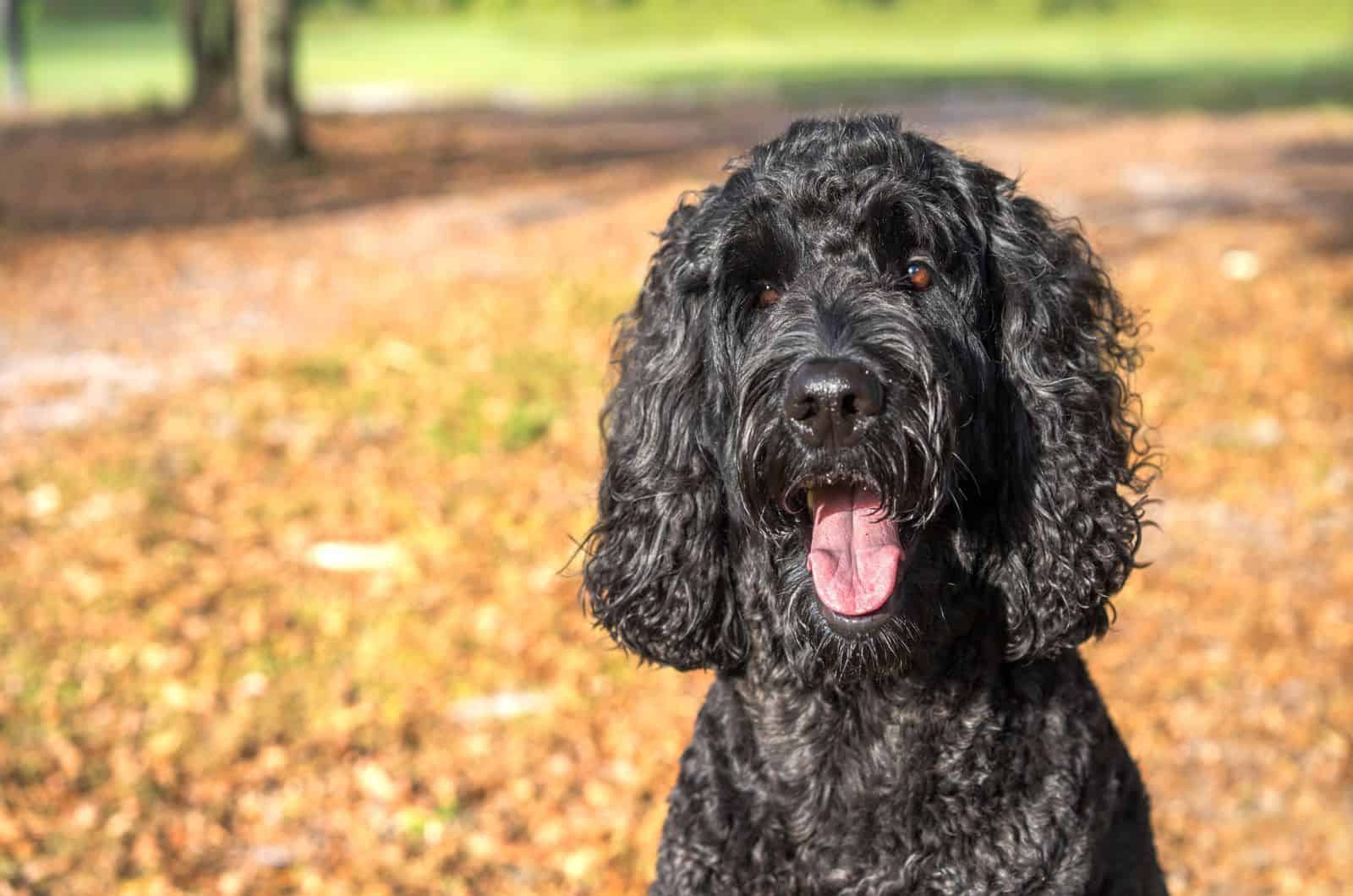
This color of Labradoodle is quite popular, but it might not be as common as the cream shade mentioned above.
The main reason for that is the fact that the black pigment also comes from a recessive gene, which requires both parent breeds to carry the same color pigment.
However, there is no guarantee that a Black Labradoodle will result from two black parent breeds as they might be born in a hazel hue or in a chocolate shade.
The highest chances of receiving a black Labradoodle are if black Labradors mix with black Poodles. Everything else will probably end up in a darker shade, but far from the black hue.
It’s important to mention that these canines don’t have the same feature of having brighter or darker parts around certain parts of their face as Labradoodles in other shades have.
A lot of people confuse these pups with black Goldendoodles; however, the black color is very uncommon in the latter Doodle type, which is why you’ll rarely have a chance to see them.
6. Blue
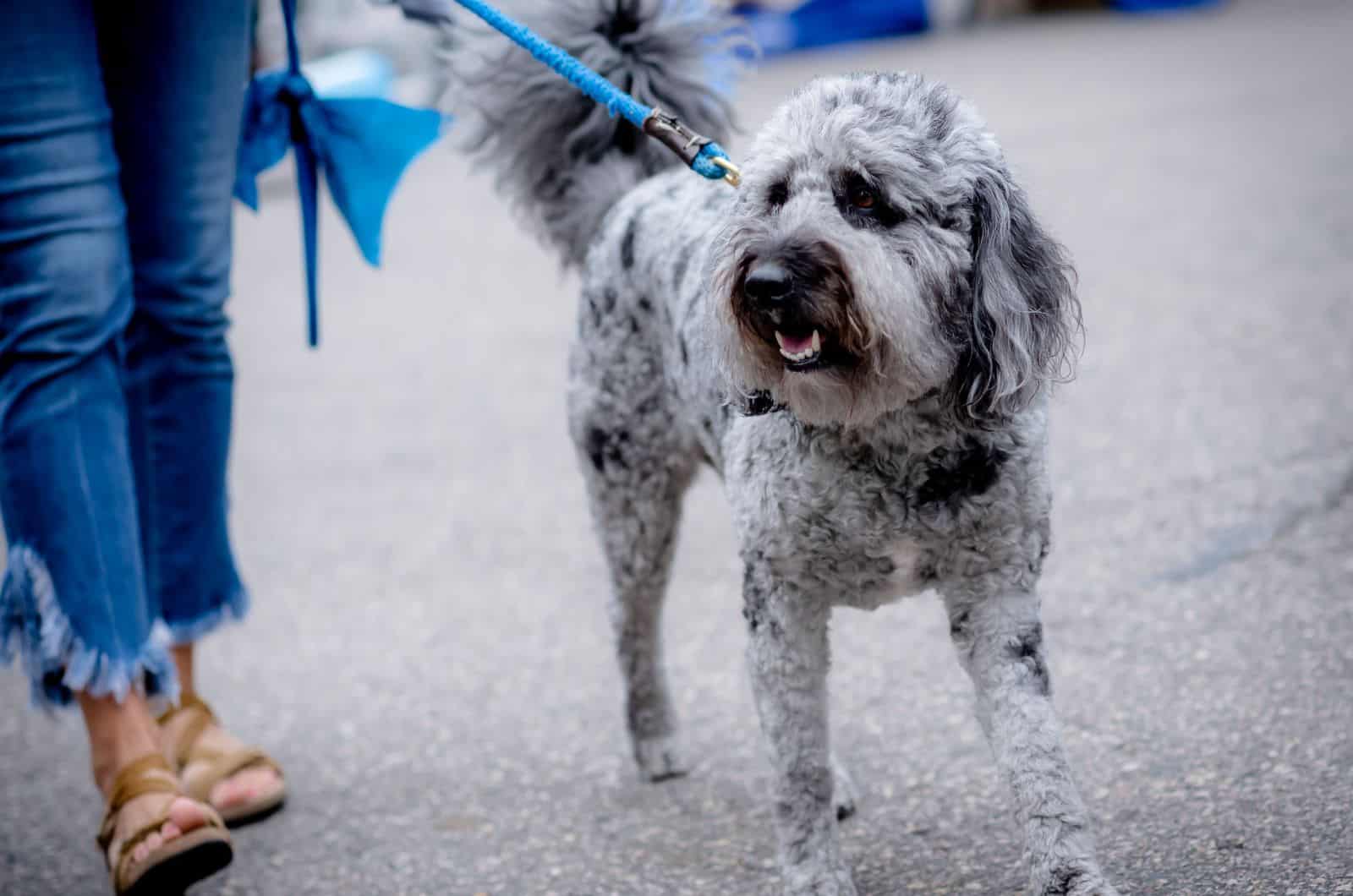
One of the main misconceptions about blue Labradoodles and blue Poodles is that they are actually colored in blue.
This shade can be best described as a dark, shadowy-gray hue, which is quite uncommon. Canines can only have this type of color if they receive the Poodle gene that causes fading of the coat shade.
On the other hand, this color can also be a result of a combination of parent breeds that are both carriers of the diluted pigment.
Two purebred canines, the blue Poodle and the standard Lab, create a pup with a unique hue that can’t be described either as gray or black.
Is Blue A Standard Color Of Labradoodles?
Blue Labradoodles are almost always born with a black coat, so it’s difficult to determine the right shade of the coat during early puppyhood.
The term ‘blue shade’ is believed to be used only to define the variation of the black hue in the color spectrum.
This shade is most commonly described as the Labradoodle’s silvery black or blue-gray hue.
7. Café
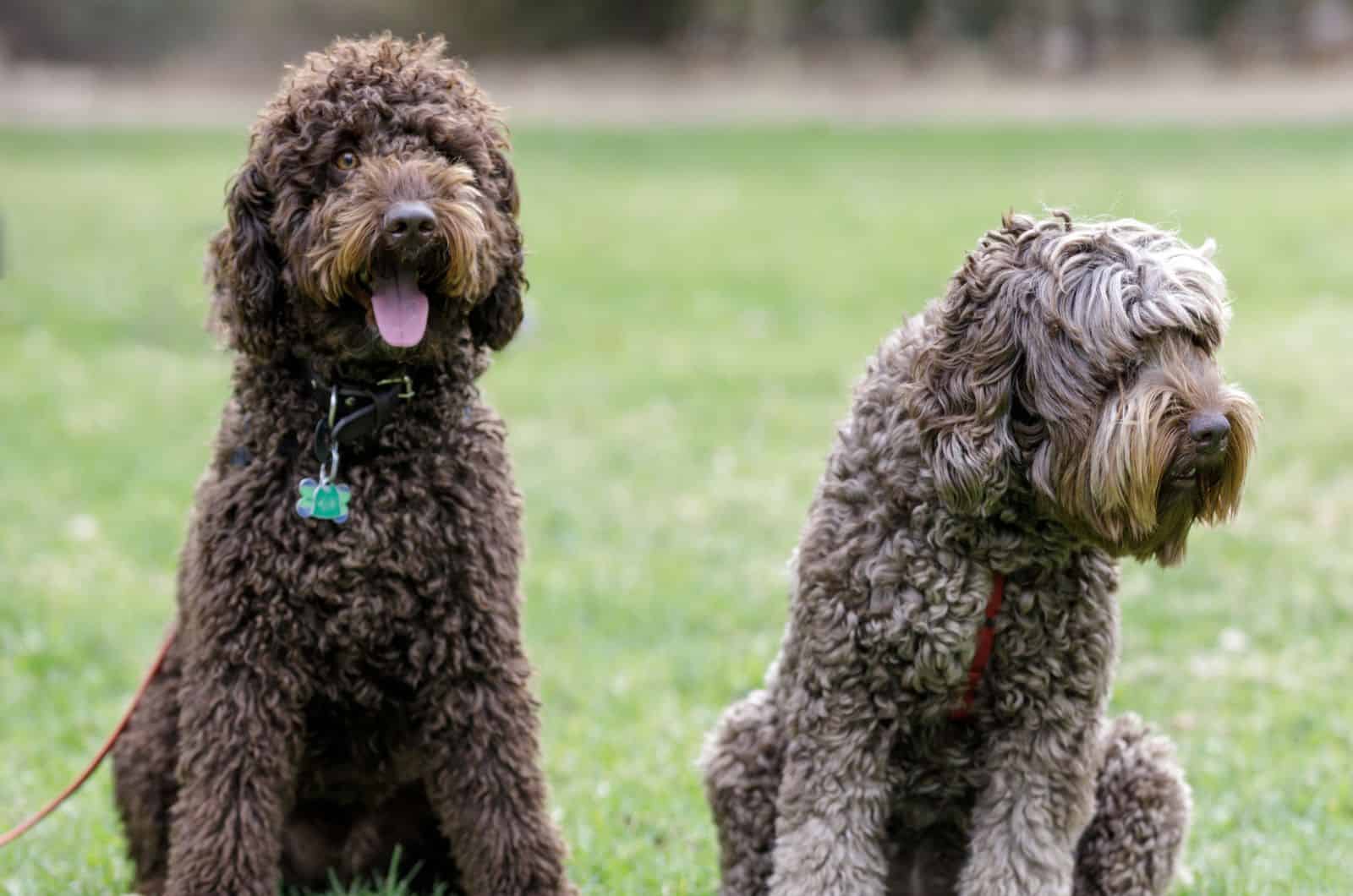
This shade is quite rare, and it is more often related to Australian Labradoodles – the combination of the Cocker Spaniel, the Lab, and the Poodle.
Aussie Labradoodles share many similar traits with the Lab and Poodle cross, including coat colors.
Both Aussies and standard Labradoodles will appear in the café color, which is commonly described as a shade combination of a bright chocolate color (milk choco shade) and a tanned-silver hue.
The dominant nose pigment is brown, which appears only if one parent possesses the same nose color.
READ NEXT: Mini Australian Labradoodle – The Cutest Doodle Out There
Is Café A Standard Labradoodle Shade?
This coat color doesn’t seem to appear as an official shade of this dog breed often, primarily because they’re defined as a subtype of chocolate Labradoodles.
However, this isn’t the only shade that is under the chocolate color category. Lavender and parchment are also often mentioned as variations of the chocolate/brown spectrum.
Many will agree that café indeed looks just like the diluted brown color, but the fact that the tips of the hair are usually found in a silvery-beige tone differentiates them from the pure choco color.
8. Chalk
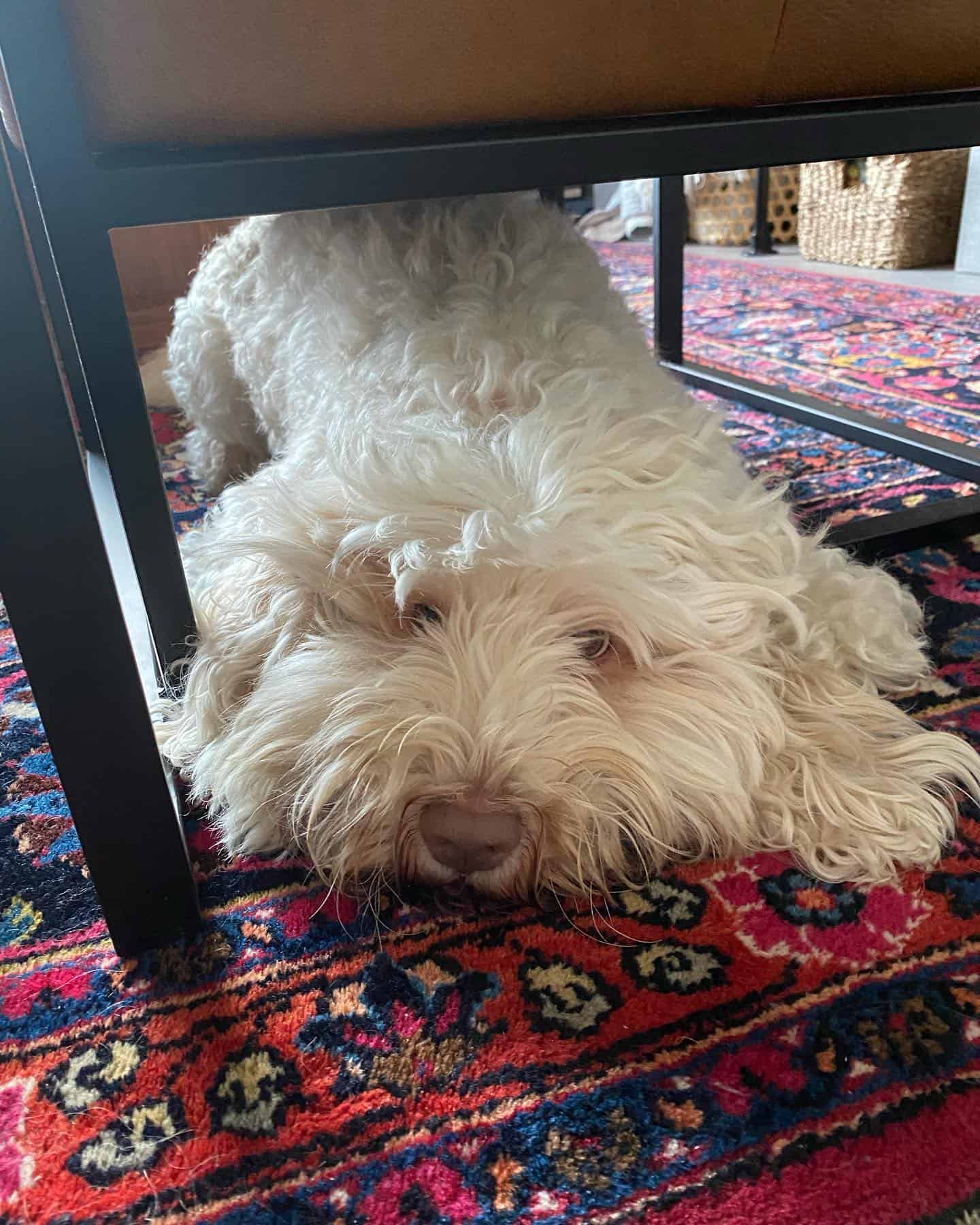
Photo from: @labradoodlesbyhazel
Chalk-white Labradoodles are often confused with cream Labradoodles, although once you get a good look at them, it’s possible to see the difference between these two shades.
They are neither white nor cream pups; if these pups stood next to white Poodles, they would look like cream pups. However, once you compare the two, you’ll notice that chalk-whites are definitely lighter than the cream Labradoodles.
The pup of the chalk-white shade should possess the same type of color all over its body, even though it’s possible for a slightly darker tint to surround certain parts of the face (eyes, nose, mouth).
Do Chalk-White Labradoodle Puppies Have Health Issues?
It is not excluded for chalk-white puppies to develop certain health issues related to the eyes, which is a part of the heritage of white (albino) canines that are prone to deafness and blindness in some cases.
Chalk-whites might not develop such serious health conditions, but one of the things that many Labradoodle owners will notice is tear-staining, which can often cause darker patches around the eyes.
White Poodles are usually more prone to tear-staining, but it can be noticed in Poodles and their mixes of other bright shades.
9. Chocolate
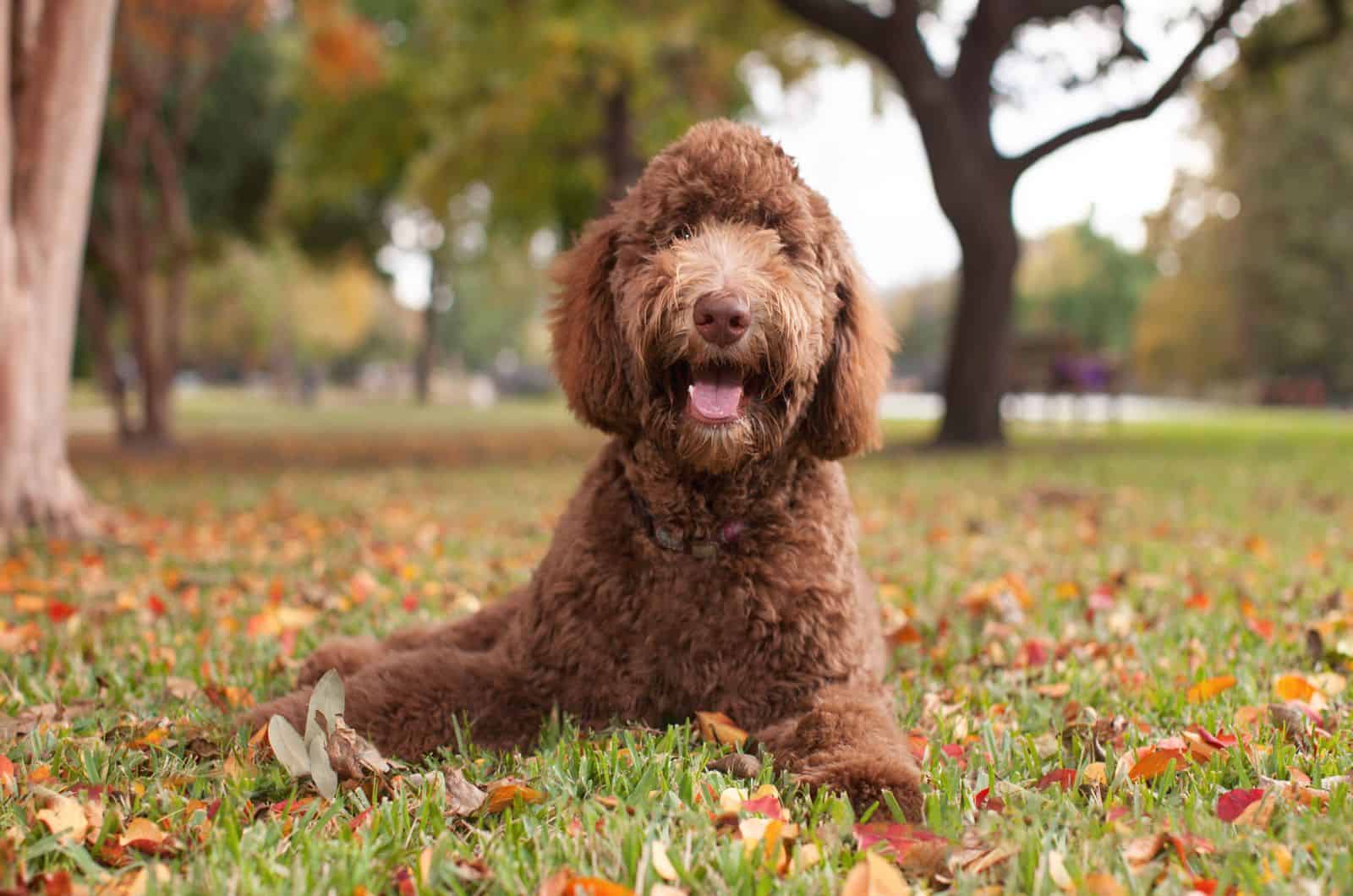
If you’ve ever seen a Labradoodle, there are high chances it was a chocolate one since it’s one of the most common color shades, along with cream and black.
One of the main reasons why chocolate Labradoodles (also called brown) are so common is the fact that this is a standard color of Labrador Retrievers.
Poodles also carry the brown gene, although this shade is richer and darker than the Lab one. Brown Poodles are usually described as pups with deep, golden-brown eyes and a rich, brown coat that have liver shade on the tips of the hair.
Brown Labradoodles are the combination of these two parent breeds, so it’s no surprise that these mixed canines come in several shades of brown.
This is because the brighter-colored dominant traits have a tendency to obscure the appearance of the darker-colored recessive genes, which is why this phenomenon occurs.
The most accurate way to characterize a Chocolate Labradoodle is to say that its hue is somewhere between pecan and mahogany.
10. Sable

Photo from: @noemiromagnoli1
This isn’t a pattern that Labradoodles are born with, making them even more interesting to many Labradoodle enthusiasts.
A Sable Labradoodle isn’t a solid shade, but rather, a combination of two different hues on each strand of hair. The main shade is always found at the base of the coat hair while the second hue appears only on the tips of it.
The base color can be either black or brown; however, these shades will soon begin to fade, leaving a much lighter coat hue when puppies become adults.
Still, some canines might retain a deeper shade on the tips of their hair, which is known as the sable pattern.
Sable Labradoodles do not differ from other types of Lab and Poodle crosses as the color doesn’t affect any part of their temperament, size, or any other feature except the coat shade.
11. Silver

Photo from: @slashthesilverdood
This is one of the rare Labradoodle colors that is often confused with the blue shade to the point that they’re usually identified as the same hue, although there are slight differences between them.
Silver Labradoodles are quite rare; this shade appears more often as a part of multicolored Labradoodles rather than a single color.
These puppies’ appealing and lovely appearance can be attributed to their unique coat shade. They have silver lines that are found all over their body, which makes the coat hair shiny.
The appearance, coat shade, and type of the Doodle puppy are usually a result of inherited characteristics from the Labradoodle’s ancestors.
Are Labradoodles Silver At Birth?
Just like blue Labradoodles, silver puppies are born with black coat hair, which makes it difficult to define the exact color of the puppy until they grow older.
In order to get a silver Labradoodle, it’s recommended to look for a reputable breeder who is an expert in Doodle crosses. This is the best way to increase the likelihood of obtaining the desired dog shade.
12. Merle
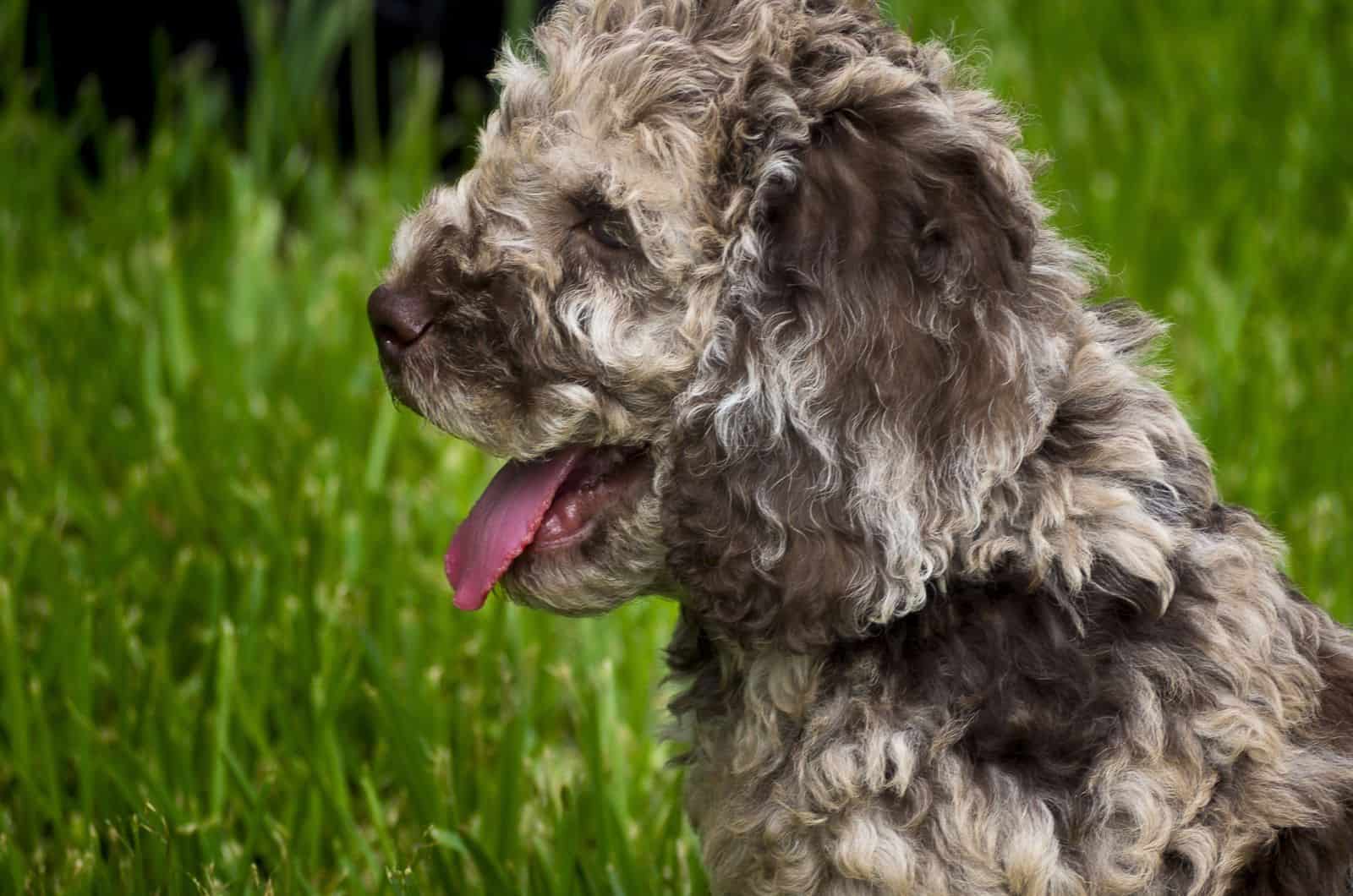
Although it’s categorized as a single color, merle is actually a shade pattern, and it should be described as such.
The Merle pattern is defined as a color gene that is responsible for the formation of multicolored spots in a solid base color of a coat.
Essentially, it can be said that a merle Labradoodle is nothing more than a Labradoodle in any solid shade, with different hue blotches.
Merle is considered to be a complex gene that still intrigues a great number of canine experts.
Merle Poodles can be crossed with merle Labradors in order to get this unique pattern, although both of these parent types are just as rare as their cross.
Are There Double Merle Labradoodles?
This phenomenon can occur in cases where two canines that possess the merle gene are crossed. There are some instances of double merle Labradoodles, although they’re pretty rare.
Unfortunately, puppies with double merle-defined markings are prone to several health issues that include hearing impairment and poor eyesight.
This is the primary reason why ethical Labradoodle breeders avoid crossing two merle pups. Therefore, every potential owner should require at least one single-colored parent, and more information on the bloodline of the pup.
13. Gray
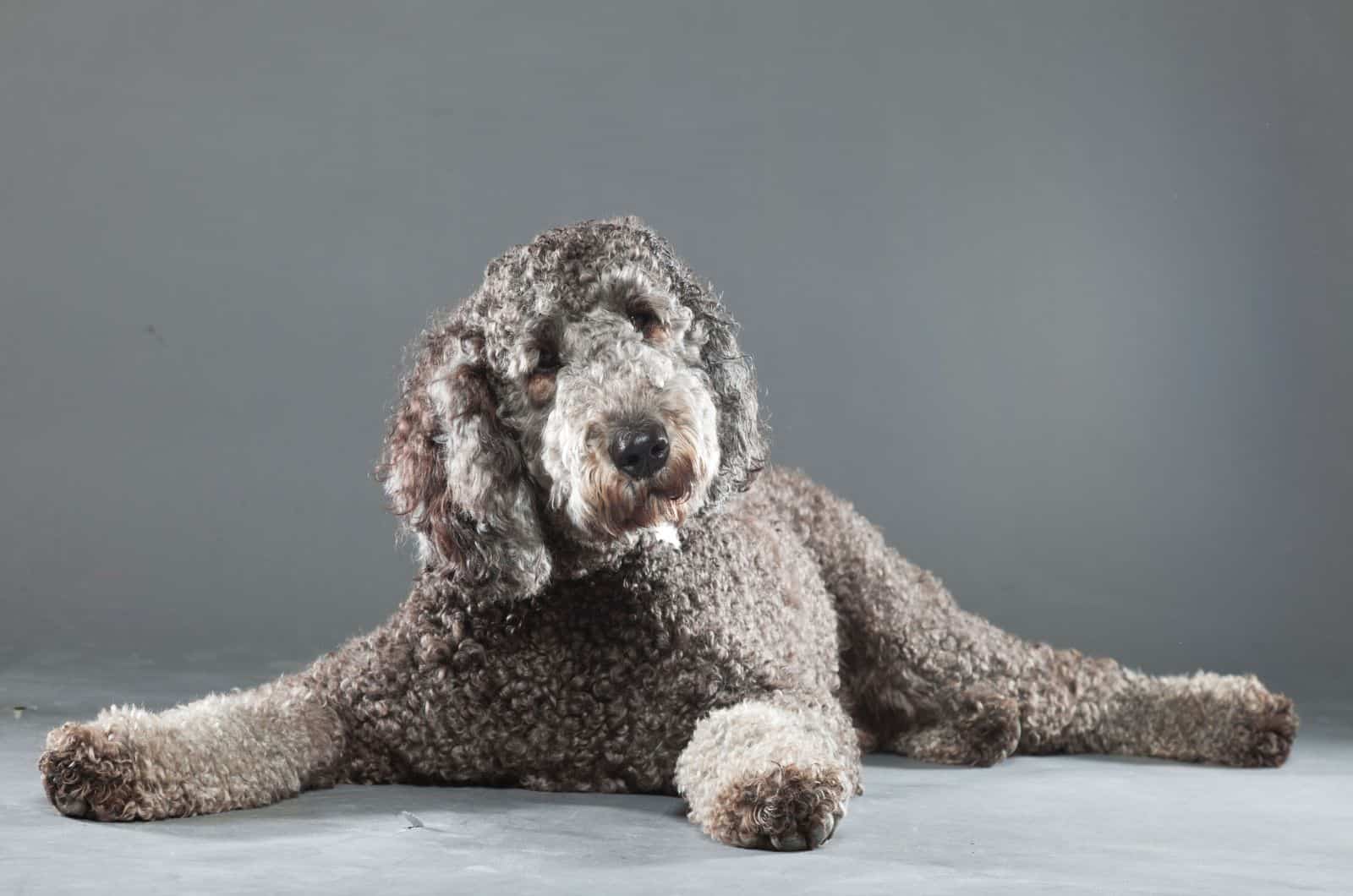
The simplest explanation of a gray Labradoodle is that it’s a combination of a Lab and a Standard Poodle with a gray coat.
Gray-colored pups get this hue as they grow older as most of them are born either brown or black.
Around the age of two, the coat of a dark Labradoodle begins to take on the appearance of lighter shades.
After they completely lose the darker appearance, they take on the gray shade, which might become even lighter during their adult years.
If you’re looking to get a gray pup that is similar to a Labradoodle, you can cross an Aussie Shepherd with a Poodle and produce an Aussiedoodle of grayish shade.
These pups are considered gray-colored Doodles despite the fact that they are not technically considered to be Labradoodles.
READ NEXT: Blue Merle Aussiedoodle: The People’s Choice
Are Gray And Silver Labradoodles The Same?
These two colors are similar to the point that many people actually identify them as the same shade. However, that might not be the case.
One of the main reasons why these two shades should be considered separate colors is the fact that the silver shade appears in lines on a darker coat while the gray hue covers the entire body.
Also, the silver hue might appear only if the coat is black from birth while the gray one appears in deeper brown puppies.
14. Phantom
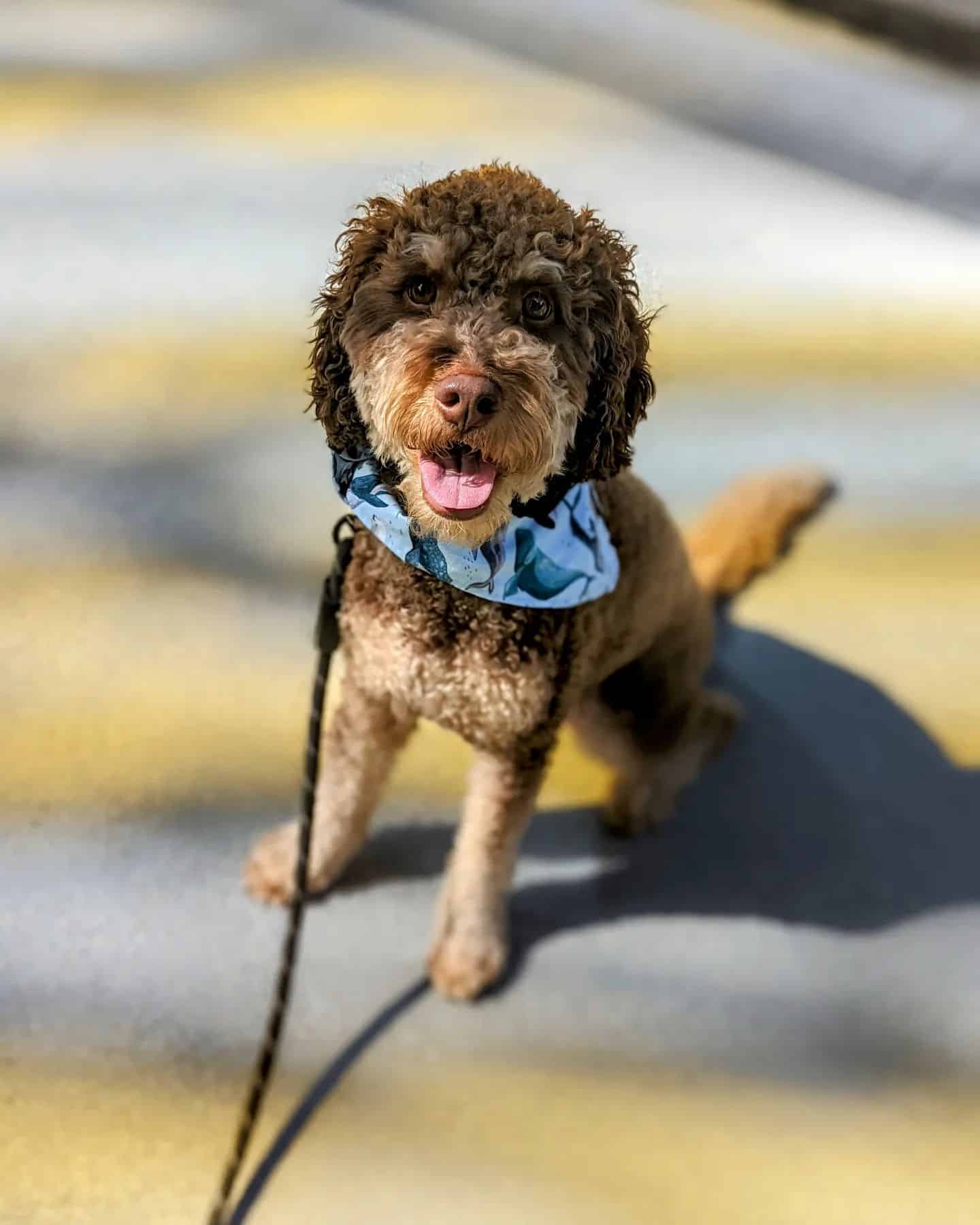
Photo from: @miss.poppy.girl
After all of the colors mentioned above, it’s time to talk about one of the rarest shades of Labradoodles. However, this isn’t the only dog breed that has a phantom coat.
Most people have already heard about the Phantom Poodle – a pup with an exceptional coat that is also the parent breed of Phantom Labradoodles.
The Poodle parent is actually the carrier of the “phantom” gene as this shade isn’t found in Labradors.
The main color of a phantom puppy should be black, although it’s not very uncommon to find phantom pups in brown (chocolate) or even blue.
The second color of this combination can be any shade, including cream and silver, along with distinctive white markings that are typically found on the chest, paws, above the eyes, and on the sides of the muzzle.
One thing is sure – these pups can’t be mixed with any other Labradoodle as their pattern is visible from the day they’re born.
With them, you’ll know which type of Labradoodle you’ll have from the first day of the puppy’s life.
15. Lavender
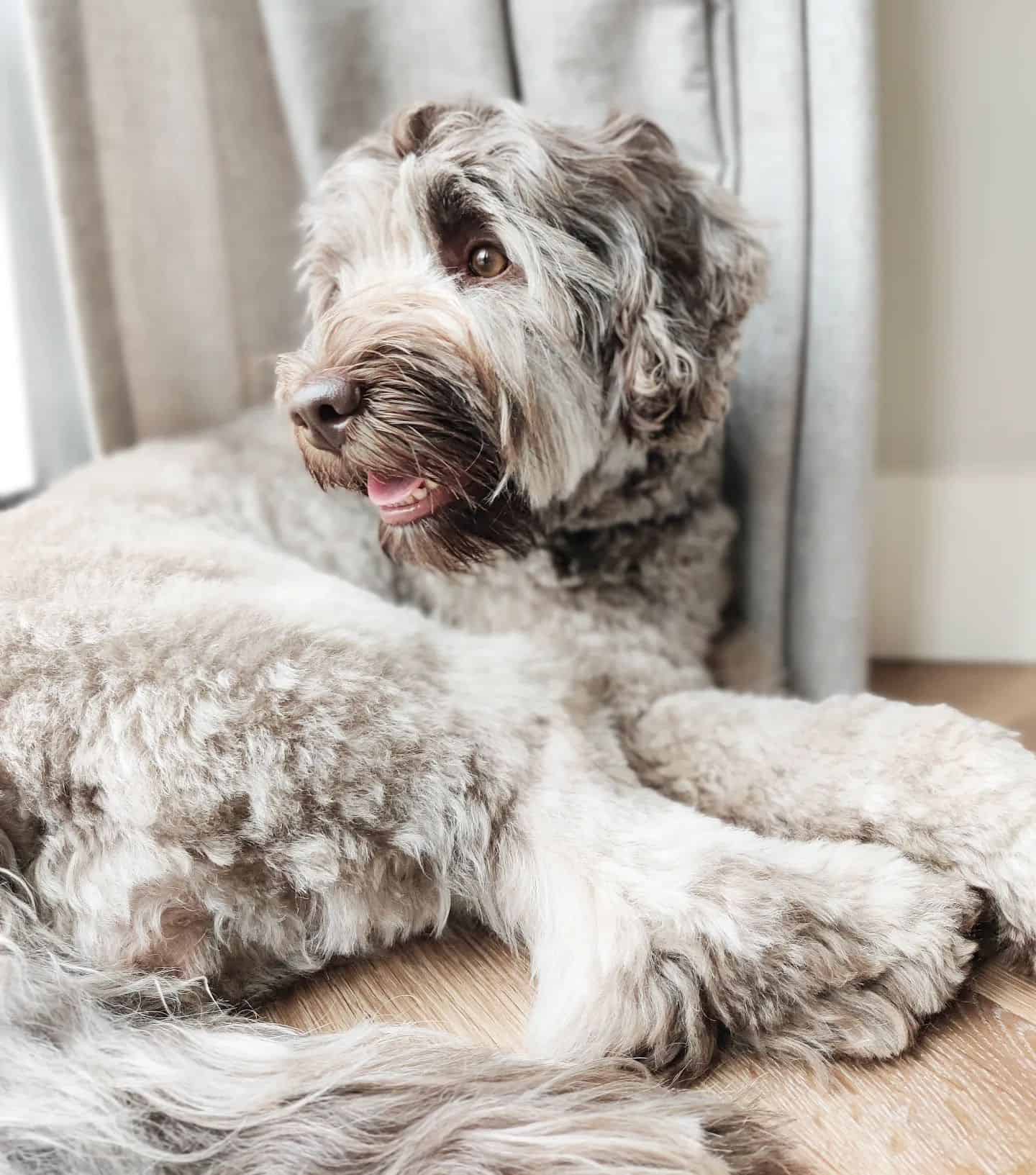
Photo from: @roxthedoodle
This is one of the unique shades of Labradoodles that is generally described as a diluted chocolate shade.
According to experts, the lavender color appears after the shade of certain chocolate Labradoodles starts to either fade or become brighter.
As the Labradoodles grow older, their coat changes from a rich brown hue to milk chocolate until they end up in a lilac-like shade, which can be defined as a grayish hue with a hint of pink.
The dilution gene doesn’t just affect the coat hair, but also the nose, which turns from brown into a deep pinkish shade.
Therefore, if you’re planning to mix or buy a mixed-breed of a chocolate Labrador and a Poodle, there might be chances that you’ll end up with a lavender pup, although it’s quite a rare sight.
16. Tuxedo
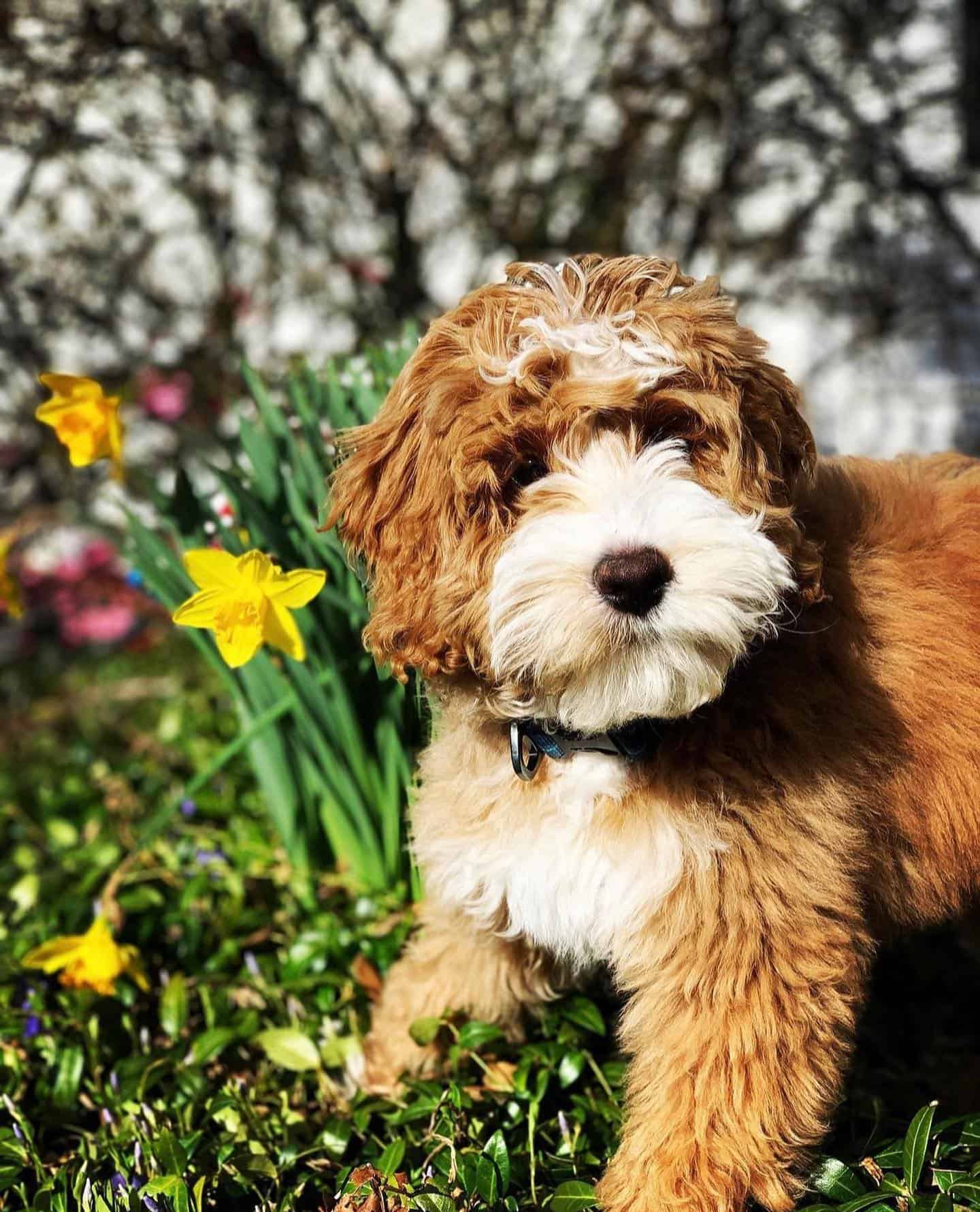
Photo from: @welcomeacreslabradoodles
This is one of the most popular colors among parti Labradoodles. The reason why these canines are called tuxedos is simply the black and white color combination in which they appear.
These pups can be easily recognized by the white markings that are found on the pup’s stomach and legs. However, the rest of their body should be colored black.
To increase the chances of getting this shade, you will have to combine a Lab of a white coat with a parti Poodle.
Are Black And White Labradoodles The Same As Tuxedos?
This is quite a tricky question that requires a detailed explanation instead of a simple yes/no answer.
Even though both types contain black and white shades, there’s a specific difference between the two.
Black and white pups usually have white color displaying around their eyes, nose, and on the top of their head, which never appears in a tuxedo pattern.
Therefore, tuxedos can’t be exactly defined as black and white Labradoodles, although they both display the same shades on their coat.
What Are Abstract Labradoodles?
This type of Labradoodle is a pooch that has several shades on their coat. Essentially, it can be any shade mixed with white color.
However, the white hue should cover less than half of their body in order for a pup to be defined as abstract.
These pups are quite rare, so it’s no surprise if you haven’t come across any so far.
What Is The Rarest Color For A Labradoodle?
If we’re talking about standard Labradoodle colors, the rarest of all shades would be the red hue.
Most people might find this answer rather confusing as they might have seen Labradoodle pups with a red coat often.
However, a red Labradoodle will not be considered complete if it has a nose pigment that is different from black.
Also, this type of doggie will need to have a solid-base red shade, which will not have any darker or brighter points on any part of the coat.
I’m sure that now you’ll be able to notice the difference between these two variations of red.
What Is The Most Common Labradoodle Coat Color?
Black is the most common shade among Labradoodles, without any doubt, which isn’t surprising since both Labradors and Poodles are often found in this same shade.
This shade is believed to possess the most dominant gene, which is transferred from parent breeds to pups.
But, black isn’t the only shade that can be found very often in Labradoodles.
Chocolate and white pups are right behind, along with apricot and cream shades.
Can Labradoodle Colors Affect Their Lifespan?
Although this might seem unlikely, in some cases, certain shades can have an impact on the life expectancy of Labradoodles.
Labradoodles have the same lifespan as Poodles – 12 to 15 years, which is a great thing considering that Labrador Retrievers usually live up to 12 years only.
However, the lifespan of Labradoodles might be shortened with the occurrence of serious health issues, including cardiovascular diseases, eye issues, or any other condition that can have a negative effect on their life.
The majority of colors mentioned above shouldn’t have any effect on the longevity of Labradoodle pups except for the double merle pups, which are prone to the development of specific health conditions.
That’s why it’s not recommendable to produce pups of this coat shade at all.
Wrapping Up
I hope this guide through all the Labradoodle colors has helped you finally understand the differences between different types of these wonderful crossbreeds.
The color of the canine shouldn’t be the deciding factor in your search for the perfect family pet, although it’s understandable if you find one color type more preferable than others.
All Labradoodles deserve to have a loving home just as much as every other canine regardless of their shades.
If you’re ready to own one, be sure that each of the Labradoodles mentioned in this list will be affectionate and amiable no matter what shade or pattern their coat is.
READ NEXT:
Micro Labradoodle: What You Never Knew About These Dogs
Labradoodle Names: The Doodliest Of Them All
Dudley Labrador: Everything You Need To Know About The Pink Nose Lab
